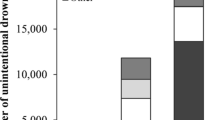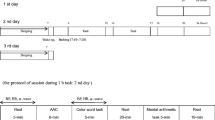Abstract
To reduce the risks of Japanese-style bathing, half-body bathing (HBLB) has been recommended in Japan, but discomfort due to the cold environment in winter prevents its widespread adoption. The development of the mist sauna, which causes a gradual core temperature rise with sufficient thermal comfort, has reduced the demerits of HBLB. We examined head-out 42 °C mist bathing with 38 °C HBLB up to the navel to see if it could improve thermal comfort without detracting from the merits of HBLB, with and without the effects of facial fanning (FF). The subjects were seven healthy males aged 22–25 years. The following bathing styles were provided: (1) HBLB—head-out half-body low bathing of 38 °C up to the navel (20 min); (2) HOMB—head-out mist bathing of 42 °C and HBLB of 38 °C (20 min); and (3) HOMBFF—HOMB with FF (20 min). HOMB raised the core temperature gradually. HOMBFF suppressed the core temperature rise in a similar fashion to HOMB. Increases in blood pressure and heart rate usually observed in Japanese traditional-style bathing were less marked in HOMBs with no significant difference with and without FF. The greatest body weight loss was observed after Japanese traditional-style bathing, with only one-third of this amount lost after mist bathing, and one-sixth after HBLB. HOMB increased thermal sensation, and FF also enhanced post-bathing invigoration. We conclude that HOMB reduces the risks of Japanese traditional style bathing by mitigating marked changes in the core temperature and hemodynamics, and FF provides thermal comfort and invigoration.







Similar content being viewed by others
References
Brinmel H, Nagasaka T, Cabanac M (1971) Enhanced brain protection during passive hypothermia in humans. Eur J Appl Physiol 56:540–545
Cabanac M (1971) Physiological role of pleasure. Science 173:1103–1107
Fukudome N (1999) Report of the survey on the current status and consciousness of bathing, by Workshop on Bathing Culture, Urban Life Research Institute, Tokyo Gas
Germain M, Jobin M, Cabanac M (1987) The effect of face fanning during recovery from exercise hyperthermia. Can J Physiol Pharmacol 65:87–91
Hirata K, Nagasaka T, Nunomura T, Hirai A, Hirashita M (1987) Effects of facial fanning on local exercise performance and thermoregulatory responses during hyperthermia. Eur J Appl Physiol Occup Physiol 55:43–48
Iwase S, Kawahara Y, Miwa C, Nishimura N (2013a) Effect and efficacy of thermal environment provided by a new bathing style, “mist sauna bathing”. Balneo Res J 4:23–34. doi:10.12680/balneo.2013.1039
Iwase S, Kawahara Y, Nishimura N, Takada H, Nagata M, Niimi Y, Miwa C (2013b) Effects of dry and mist saunas on circulatory and thermoregulatory functions in humans. Health 5:267–273. doi:10.4236/health.2013.52036
Kato M, Sugenoya J, Matsumoto T, Nishiyama T, Nishimura N, Inukai Y, Okagawa T, Yonezawa H (2001) The effects of facial fanning on thermal comfort sensation during hyperthermia. Pflügers Arch Eur J Physiol 443:175–179
Kawahara Y, Nagata M, Niimi Y, Miwa C, Iwase S (2002) Effects on changes in hemodynamic and thermoregulatory functions during mist and dry sauna bathing. Auton Nerv Syst 39:402–408
Kawahara Y, Iwase S, Miwa C, Kataoka Y, Watanabe Y (2003) Effect of head-out mist bathing and facial fanning on thermoregulatory and cardiovascular functions and thermal comfort during half-body bathing in humans. Auton Nerv Syst 40:43–50
Miwa C, Iwase S, Koide Y, Sugenoya J, Sugiyama Y, Matsukawa T, Mano T, Yamaguchi K (1994) Effects of bathing at 40°C for 60 minutes on cardiovascular and thermoregulatory functions in humans. Auton Nerv Syst 31:38–46
Miwa C, Iwase S, Sugiyama Y, Matsukawa T, Mano T, Koide Y (1998) Effects of the water temperature on hemodynamic change and thermoregulatory function during bathing in humans. Gen Rehabil 26:355–361
Miwa C, Iwase S, Sugiyama Y, Matsukawa T, Mano T, Koide Y (1999a) Effects of ambient temperature on hemodynamic and thermoregulatory functions during bathing in humans. Gen Rehabil 27:353–358
Miwa C, Iwase S, Mano T (1999b) Mist heat effects on thermoregulatory function during bathing at 41°C in humans. Auton Nerv Syst 36:478–484
Miyazawa T, Horiuchi M, Ichikawa D, Subudhi AW, Sugawara J, Ogoh S (2012) Face cooling with mist water increases cerebral blood flow during exercise: effect of changes in facial skin blood flow. Front Physiol 3:308, Epub 2012 Aug 2
Ohtsuka Y (2000) Physiology of bathing. J Integr Med 10:830–834
Takahashi R, Kato Y, Kihira H et al (2001) Annual Report on the Survey of Prevention and Countermeasure of Accidents during Bathing, Annual Report for fiscal year of 2000, Tokyo Emergency Foundation, pp 27–33
Tochihara H (2006) Bathing of Japanese people. Its merits and demerits. Center of Excellence Program for 21st Century Workshop, Safety and Comfortableness of Bathing, School of Design, Faculty of Design, Kyushu University, Fukuoka, 2–5
Yamakawa M, Nagai Y (2002) Survey on seasonal status of half body bathing. Living Information Release by Ohsaka Gas
Acknowledgments
The authors are grateful for the subjects who participated in this study. This study was performed as cooperative research between Aichi Medical University and TOTO Co. Ltd.
Author information
Authors and Affiliations
Corresponding author
Additional information
S.I. and K.Y. contributed equally to this publication.
Rights and permissions
About this article
Cite this article
Iwase, S., Kawahara, Y., Nishimura, N. et al. A comparison of head-out mist bathing, with or without facial fanning, with head-out half-body low-water level bathing in humans—a pilot study. Int J Biometeorol 58, 999–1005 (2014). https://doi.org/10.1007/s00484-013-0685-4
Received:
Revised:
Accepted:
Published:
Issue Date:
DOI: https://doi.org/10.1007/s00484-013-0685-4




